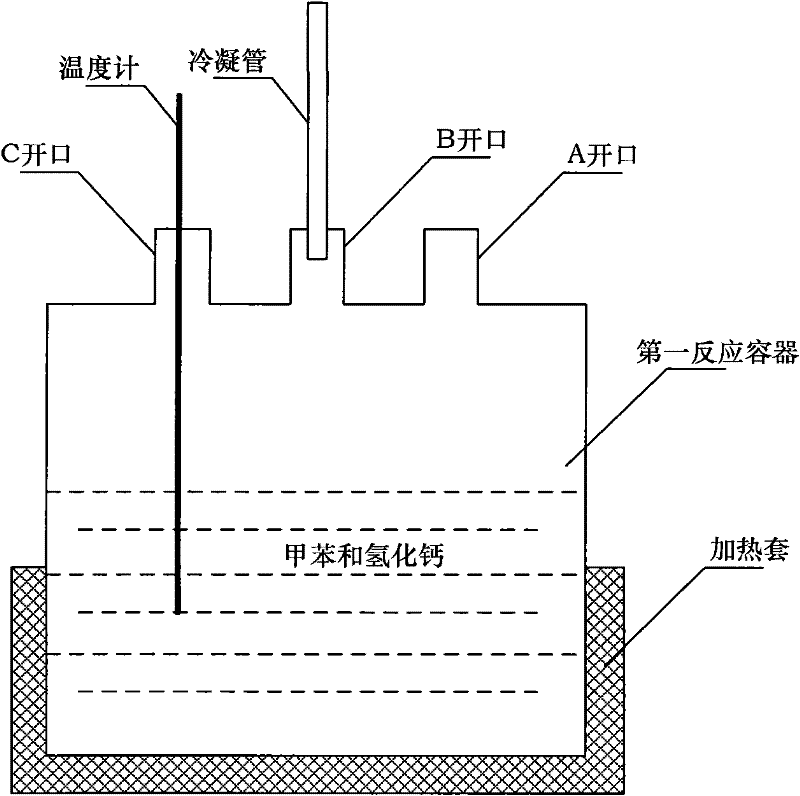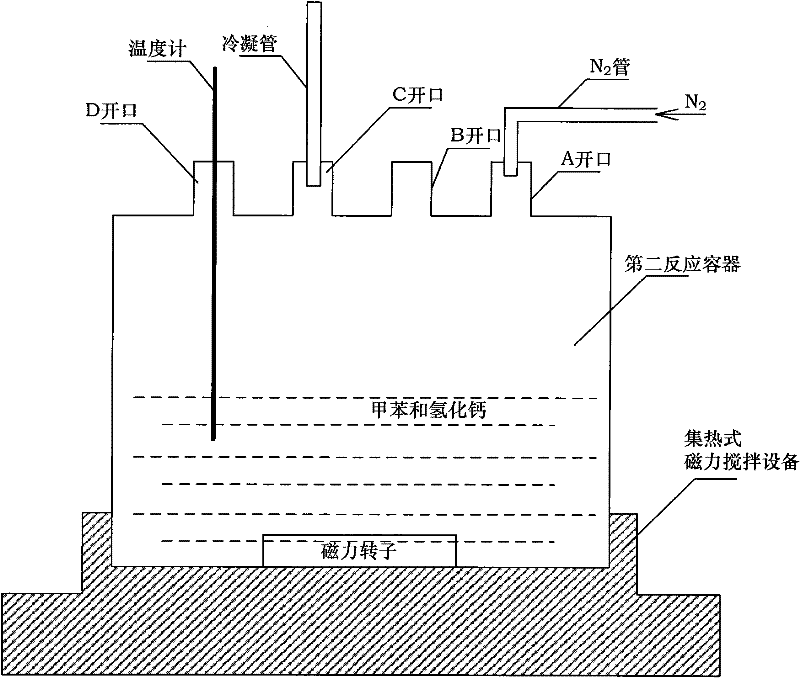Preparation method of SiC-SiAlCN glass ceramics
A kind of glass-ceramic and a technology for manufacturing method, which are applied in the field of manufacturing non-oxide glass-ceramic prepared by high-temperature pyrolysis of ceramic precursor polymer alloy
- Summary
- Abstract
- Description
- Claims
- Application Information
AI Technical Summary
Problems solved by technology
Method used
Image
Examples
Embodiment 1
[0074] Step 1: Preparation of anhydrous toluene
[0075] Toluene C 6 h 6 and calcium hydride CaH 2 Put it into the first reaction vessel through the opening of A, reflux at a temperature of 105°C (measured by a thermometer in real time) to remove traces of water in toluene, and then distill at 110°C (measured by a thermometer in real time) to obtain anhydrous Toluene; 5g of calcium hydride was added to 100ml of toluene;
[0076] Step 2: Preparation of liquid polyaluminum silazane (PAS)
[0077] (A) Fill the second reaction vessel with N for 10 min through the opening of A 2 , N 2 The flow rate is 40ml / min; (B) aluminum hydride and polysilazane are loaded into the second reaction vessel through the B opening; (C) the rotating speed of the PTFE magnetic rotor is adjusted to be 800r / min by a magnetic stirring device; (D) After stirring and reacting at a temperature of 22°C for 100 minutes, and then stirring and reacting at a temperature of 40°C for 10 hours to obtain liquid...
Embodiment 2
[0094] Step 1: Preparation of anhydrous toluene
[0095] Toluene C 6 h 6 and calcium hydride CaH 2 Put it into the first reaction vessel through the opening of A, reflux at a temperature of 108°C (measured by a thermometer in real time) to remove traces of water in toluene, and then distill at 112°C (measured by a thermometer in real time) to obtain anhydrous Toluene; 10g of calcium hydride was added to 100ml of toluene;
[0096] Step 2: Preparation of liquid polyaluminum silazane (PAS)
[0097] (A) Fill the second reaction vessel with N for 5 min through the opening of A 2 , N 2 The flow rate is 40ml / min; (B) trimethylalumane and polysilazane are loaded into the second reaction vessel through the B opening; (C) the rotating speed of the tetrafluoromagnetic rotor is adjusted to 700r / min by a magnetic stirring device; (D) Stir and react at a temperature of 20°C for 50 minutes, and then stir and react at a temperature of 40°C for 10 hours to obtain liquid polyaluminosilaza...
Embodiment 3
[0112] Step 1: Preparation of anhydrous toluene
[0113] Toluene C 6 h 6 and calcium hydride CaH 2 Put it into the first reaction vessel through the opening of A, reflux at a temperature of 110°C (measured by a thermometer in real time) to remove traces of water in toluene, and then distill at 112°C (measured by a thermometer in real time) to obtain anhydrous Toluene; add 1g of calcium hydride to 100ml of toluene;
[0114] Step 2: Preparation of liquid polyaluminum silazane (PAS)
[0115] (A) Fill the second reaction vessel with N for 10 min through the opening of A 2 , N 2 Flow rate is 30ml / min; (B) metal aluminum organic matter and polysilazane are packed in the second reaction vessel through B opening; (C) the rotating speed of adjusting tetrafluoromagnetic rotor by magnetic stirring equipment is 600r / min; (D ) after stirring and reacting at a temperature of 25°C for 150 minutes, and then stirring and reacting at a temperature of 45°C for 15 hours to obtain liquid pol...
PUM
| Property | Measurement | Unit |
|---|---|---|
| particle size | aaaaa | aaaaa |
Abstract
Description
Claims
Application Information
 Login to View More
Login to View More - R&D
- Intellectual Property
- Life Sciences
- Materials
- Tech Scout
- Unparalleled Data Quality
- Higher Quality Content
- 60% Fewer Hallucinations
Browse by: Latest US Patents, China's latest patents, Technical Efficacy Thesaurus, Application Domain, Technology Topic, Popular Technical Reports.
© 2025 PatSnap. All rights reserved.Legal|Privacy policy|Modern Slavery Act Transparency Statement|Sitemap|About US| Contact US: help@patsnap.com



